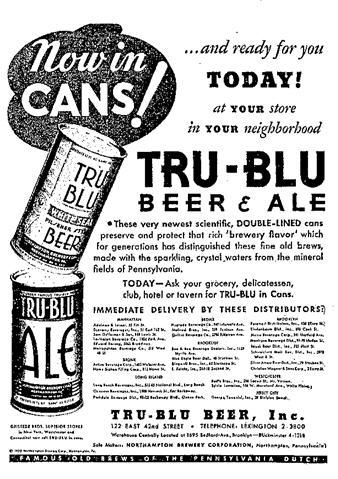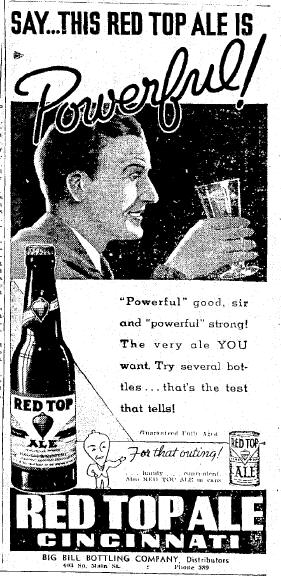The First Cans from National Can Company
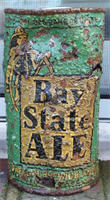 |
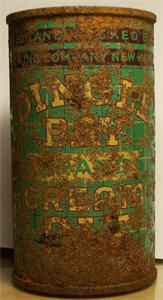 |
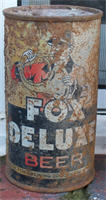 |
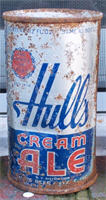 |
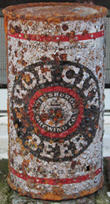 |
 |
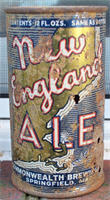 |
 |
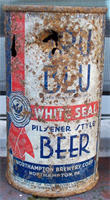 |
This month I wanted to show off a new can I acquired recently, a Red Top Ale OI from Cincinnati. However, I've already discussed Red Top Brewing -- see my September and October 2005 COM's-- so instead, I want to concentrate on the can company that made the can, National Can. They were one of the first companies to make beer cans, but they seemed to run into problems as none of their original customers kept using their product. After World War II they had to start fresh.
American Can Company started the ball rolling with canning beer in early 1935 when they got Krueger Brewing to sell their beer in cans in Richmond, Virginia. (They experimented with cans filled with Krueger's in 1933 with a small test audience) Other canning companies jumped in immediately after.
- In June 1935 National signed Northampton Brewing Company.
- In August the G. Heileman Brewing Company signed with Continental to use their cone top cans.
- In December the California Brewing Association (Acme Beer) signed with Pacific Can.
- In 1936 Crown Cork & Seal of Baltimore started selling conetops with a paper label. Only one brewery, Ebling of New York, used this can, but in 1937 CC&S found more success with their new cone top cans, known to collectors as " J-spouts." Their can division was the "Crown Can Company." They also produced a flat top sometime about 1937-1938.
The biggest brewers of the time, Anheuser-Busch, Schlitz, Pabst, Ballantine, tended to either go with American's flat tops (AB, Pabst, Ballantine), or with Continental's cone tops (Schlitz). Crown Cork and Seal and National tended, with a few exceptions, to get smaller breweries. I'm not certain why this was, but I have a couple ideas.
According to one suggestion, American Can already had as many brewery customers as they could deal with, so they turned away some of the smaller breweries to deal with larger companies. If one of these smaller breweries wanted to use flat top cans then they had to turn to CC&S or National. Crown's flat tops were different than the other companies'. They were taller and thinner (although they also held 12 oz) and only a couple breweries used them, and then only briefly. That left National to pick up American's rejected customers.
One of the biggest hurdles for each can company in making a beer can was the can lining. Beer reacts very poorly with metal and if the beer came in contact with the can's metal, it would very quickly become undrinkable. So each can had to be lined. American Can used a spray-on plastic called "Vinylite." They called their system Keg-Lined." Continental used a wax compound. National also used Vinylite, although they called their lining system "Double-Lined." The National can were lined with both a wax and the plastic. Crown Can called their lining "Fermax."
National had problems with their initial lining, causing it to break down, spoiling the beer. They also had problems with their lids and seams. These problems may certainly have had something to do with the fact that National seemed to have difficulty keeping some of their customers. According to Kevin Lilek's United States Beer Cans with Opening Instructions, National's Chicago plant accidentally reversed the order in which the two linings were added. As a result the lining broken down and spoiled the beer. According to the author, this is why some breweries ended their relationship with National.
Let's look at the breweries one at a time, and see how long each used National Can Company's early flat tops.
Here is the timeline for National Can adding breweries.
June 1935: Northampton Brewing
September 1935: Peter Fox Brewing
February 1936: Stroudsburg Brewing
March 1936: Commonwealth Brewing
August 1936: Pittsburgh Brewing
Northampton Breweries, Northampton, Pennsylvania
Northampton was one of the the breweries that stuck it out with National the longest. They were the first to sign and used the flat tops until civilian canning stopped in World War II. However, sometime about 1939-1940 they also began using Crown Cork and Seal cans, both a 10 oz j-spout, and the 12 oz crowntainers. After World War II they canned their product in quart cans, Tru Blue Ale, the Beer and another brand, Blue Crest. The crowntainers were made by Crown Cork and Seal, as were most of the quarts. Continental and CC&S both made quart cans for the Beer.
|
|||
Red Top Brewing, Cincinnati, Ohio
|
|||
Peter Fox Brewing, Chicago, Illinois
Fox's flagship brand was Fox Deluxe Beer. Their cans went through several variations from 1935-1938. Their first canned brand was Fox Export, which was sold in late 1935 and early 1936. Fox De Luxe (two words) brand came out in cans later in 1935. Fox Deluxe (one word) came out in cans starting in 1937. Breweries sometimes came out with brands other than their flagship when first using cans. If the canning experiment flopped it wouldn't hurt the brewery's main brand. Pabst, for example, canned "Pabst Export" before they trusted their "Pabst Blue Ribbon" to the new containers. According to United States Beer Cans with Opening Instructions, Fox did in fact change their label, and abandon Fox Export" after their cans from National suffered from lining problems resulting in spoiled beer. The design changes are not very radical, however, so they may not have felt that a complete rebranding was necessary. In late 1938, however, Peter Fox Brewing switched to cans made by American Can. The new cans were identical, except for the can company information printed on the back. In 1938 Fox also experimented with an 8 oz flat top produced by Crown Cork and Seal. The cans may not have sold very well as they were not used for very long and it wasn't until the 1950s that 8 oz flat top cans were again tried. Peter Fox also canned a store brand, Hillman's America's Pride, from 1936-1938. Made for Hillman's grocery store chain there are only two examples of the can known, both found in Wisconsin. Until the late 1990s they were only known from newspaper and magazine advertisements. Just to make it more frustrating for the collector, the two known Hillman's cans are somewhat different from one another. Begriming in late 1938 Hillman's was sold in cans from American Can. These latter cans are fairly common.
|
|||
King's Brewing, Brooklyn, New York
|
|||
Stroudsburg Brewing, Stroudsburg, PennsylvaniaThis is one of several short-lived brands that used National cans. Stroud Cream Ale and Stroud Export Beer were canned from mid 1936 until early 1937. Sometime in early-mid 1937 the brewery closed. There are two variations of the beer can and one known variation of the ale. All are rare in good condition and uncommon even as dumpers. They have been dumped in Pennsylvania, New York and New England.
|
|||
Commonwealth Brewing, Springfield, Massachusetts
Commonwealth cans have been dumped all throughout New England and there are numerous variations of each (except for the rare New England Beer.) The brewery closed in 1948 and did not can any of their beers again after World War II. For more details on Commonwealth see my September 2006 COM.
|
|||
Pittsburgh Brewing, Pittsburgh, Pennsylvania
What happened? Apparently the lining in the cans had problems resulting in spoiled beer. Pittsburgh Brewing abandoned the cans before they could do irrevocable harm to their reputation. As noted earlier, abandoning flat top cans was not a decision to take lightly, as using flat tops required a special canning line with its own equipment. The first Iron City can is rare. Interestingly, it does not appear that any other breweries signed with National after Iron City until after World War II. This suggests that Pittsburgh Brewing's problems were a) so awful as to ruin National's reputation among brewers or b) that they were not the only brewers to suffer problems with National's cans which also discouraged potential customers. On a side note, Iron City did start using flat tops again in the 1950s and were the first brewery to experiment with pull top cans.
|
|||
Hull Brewing, New Haven, Connecticut
The brewery closed in 1977.
|
|||
Regal Brewing, Detroit, MichiganRegal Brewing had made liquid malt (for baking and home brewing) during Prohibition. It opened as a brewery in late 1935. A small brewery, it only produced 60,000 barrels of ale and lager beer in 1936. In late summer of 1936 they signed a contract with National for their cans. In February 1937 the brewery was sold to another Detroit Brewery, Ekhardt & Becker. The brewery was closed in 1938. It's possible that problems with National's cans hurt Regal's business, but there are other, equally likely reasons for its early closing. The brewery's owners had a brand new facility built, which may have financially over-extended them. Many new breweries closed between 1933-1941 because when Prohibition ended more breweries had opened than were needed to fulfill demand. Also, the economy lapsed into a short, sharp recession in 1937, which also caused some breweries in weak financial condition to close, such as the King's Brewery discussed previously. For whatever reason, the Regal Brewery was very short-lived. There is one variation of the Regal can and it is quite rare. There are only a few rough dumpers and one nice indoor example known. |
Sources Used
Special thanks to Marc Tracy & Matt Menke for all the help and to Leon for the article.
Blum, Peter H. Brewed in Detroit: Breweries and Beers Since 1830. (Detroit, 1999).
"Business: Beer Listed and Canned" Time (23 September 1935).
"Can Equipment Installed in Peter Fox Brewery" Hammond (indiana) Times. 16 November 1935.
Cushman, Gary, Dave Lang, et al. New England Breweriana. (Schiffer Publications, 2001)
Holian, Timothy J. Over the Barrel: The Brewing History and Beer Culture of Cincinnati. Volume 2. Prohibition-2001. (Sudhaus, 2001)
www.keglined.com A great site, very informative.
Skilmik, Bob. The History of Beer and Brewing in Chicago, 1833-1978. (St. Paul, 1999)
Van Wieren, Dale P. American Breweries II. (West Point, PA., East Coast Breweriana Association, 1995)

